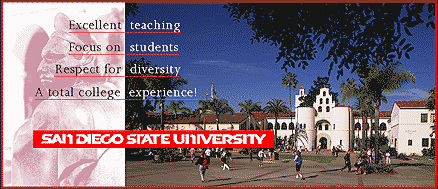Lessons Learned from In-Service Teacher Enhancement
in Computational Science
SIAM Annual Conference
Kansas City, Mo
July 23,1996
This URL is stewart.sdsu.edu/siam96/ Updated 15July2025

Dr. Kris Stewart (stewart@sdsu.edu)
Associate Professor, Mathematical & Computer Sciences Department
San Diego State Univeristy
San Diego, CA 92182
and
 Computational Science Curriculum Coordinator
Computational Science Curriculum Coordinator
San Diego Supercomputer Center
Abstract:
This poster presents STEP (Supercomputer Teacher Enhancement
Program), an in-service program for high school
science and math teachers, with significant underrepresented
student populations. STEP was funded by the NSF to provide
training on tools and techniques of Computational Science
at the San Diego Supercomputer Center. STEP began in 1993
(before NCSA Mosaic "hit the net") and the group has
advanced with the times. The participants have developed
extensive Web based materials applicable to the high school
class room.
Three years of work with teachers has taught this author much
that she would like to share. Intensive summer workshops,
follow-on Saturday meetings during the academic year and the
culminating presentations by the STEP participants at
SUPERCOMPUTING '95 were some of the components of the
program.
STEP has recently been included in the permanent collection of the
Smithsonain Institution on the use and impact of information
technology.
STEP
HPCCC = High Performance
Computation
Communication
Collaboration
STEP documents from anonymous ftp site
A Discussion -
I would like to mention some projects that provide curricula materials in
Computational Science via the Web. These are all
dynamic activities involving myself and others, therefore only a snapshot
will be presented in these notes. Interested readers are encouraged to go
directly to the original source on the WWW, since the materials have
undoubtedly changed.
- Undergraduate Activities
-
- Supercomputing for the Sciences (SDSU Course)
- https://stewart.sdsu.edu/cs575/
One semester, senior level course which takes students with a background
in programming and introduces them to high performance computing with
a focus on scientific applications.
- High Performance Scientific Computing [HPSC]
-
Overview Scientific Computing 33pgs
One year, senior level course sequence at the University of Colorado,
Boulder on High Performance Scientific Computing developed by
Dr. Lloyd Fosdick and Dr. Elizabeth Jessup.
- Undergraduate Computational Science and Engineering [UCES]
-
UCES at Ames Lab, Ames IA
Voluntary, cooperative faculty group sponsored by the Department
of Energy to develop undergraduate curricula in computational science.
The winners of the 1996 Undergraduate Computational Science Award
have been recently announced and are available via the Web.
- Introducing Computational Programming & Visualization (SDSU course)
- https://stewart.sdsu.edu/cs205/
One semester, sophomore level course which takes students with a
math background from freshman calculus and introduces
them to C programming and scientific visualization within the MATLAB
software environment. The focus is on scientific problem solving
through programming and visualization.
- Compendium of Computational Science Education Programs
- C.D. Swanson - Cray Research Inc./Krell Institute
university programs 66pgs, 2003
https://citeseerx.ist.psu.edu/document?repid=rep1&type=pdf&doi=0de26bddbaa8038cdd29b187a7e4330a3e8760f1
High School Activities
-
-
- STEP, Supercomputer Teacher Enhancement Program
only available from the Internet Archive, Way Back Machine
- Supercomputer Teacher Enhancement Program [STEP] is funded by the
National Science Foundation and is a project of the University of California,
San Diego (UCSD) and the San Diego Supercomputer Center (SDSC). STEP provides
an opportunity for high school science teachers to learn about the uses
of computational science in the classroom as well as in research.
-
-
https://stewart.sdsu.edu.edu/smithsonian
- STEP is been included Computerworld/Smithsonian Award
Information Technology exhibit, a permanent on-line presentation
at the Museum of American History.
-
- http://nebbs.nersc.gov/ (no longer available)
- National Education Supercomputer at Lawrence Livermore Labs
provides access to the Cray High School Supercomputer. The Web
site also provides a wide variety of "simple to use" applications
that can run on the Macintosh at a remote site (the high school
teacher's classroom, say). These routines
interface with the Cray over the network to solve problems
in climate modeling, molecular dynamics and more.
Final Thoughts
- Talk to "real" people
-
A guiding thought that has worked for me is:
Always have a plan, but be flexible since "stuff happens"
that you cannot always control.
Unfortunately, there is a fine line between deciding
that "life has changed and it's time to set a new course"
and leading a life that is too scattered to be productive.
- Watch out for "info overload"
- Information technologists are still working on the human interface
to information, as well as the human interface to the computer. At the
moment, the overwhelming amount of available information available,
with little or no facility for peer-reviewed critical evaluation, puts a
tremendous burden on the seeker of information. This may be a student,
or faculty member, or staff member.
stewart.sdsu.edu/infolab/
return to Kris' home page


